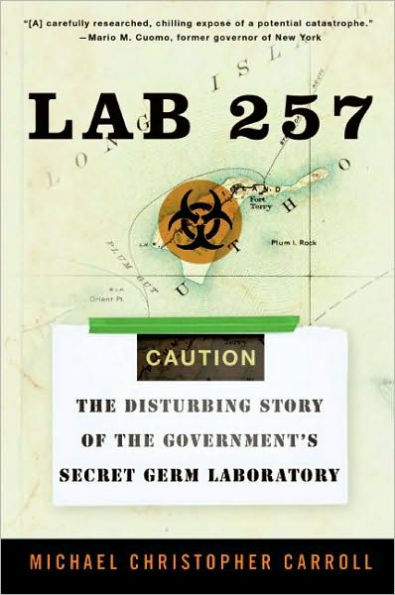Strictly off limits to the public, Plum Island is home to virginal beaches, cliffs, forests, ponds -- and the deadliest germs that have ever roamed the planet. Lab 257 blows the lid off the stunning true nature and checkered history of Plum Island. It shows that the seemingly bucolic island in the shadow of New York City is a ticking biological time bomb that none of us can safely ignore.
Based on declassified government documents, in-depth interviews, and access to Plum Island itself, this is an eye-opening, suspenseful account of a federal government germ laboratory gone terribly wrong. For the first time, Lab 257 takes you deep inside this secret world and presents startling revelations on virus outbreaks, biological meltdowns, infected workers, the periodic flushing of contaminated raw sewage into area waters, and the insidious connections between Plum Island, Lyme disease, and the deadly West Nile virus. The book also probes what's in store for Plum Island's new owner, the Department of Homeland Security, in this age of bioterrorism.
Lab 257 is a call to action for those concerned with protecting present and future generations from preventable biological catastrophes.
Strictly off limits to the public, Plum Island is home to virginal beaches, cliffs, forests, ponds -- and the deadliest germs that have ever roamed the planet. Lab 257 blows the lid off the stunning true nature and checkered history of Plum Island. It shows that the seemingly bucolic island in the shadow of New York City is a ticking biological time bomb that none of us can safely ignore.
Based on declassified government documents, in-depth interviews, and access to Plum Island itself, this is an eye-opening, suspenseful account of a federal government germ laboratory gone terribly wrong. For the first time, Lab 257 takes you deep inside this secret world and presents startling revelations on virus outbreaks, biological meltdowns, infected workers, the periodic flushing of contaminated raw sewage into area waters, and the insidious connections between Plum Island, Lyme disease, and the deadly West Nile virus. The book also probes what's in store for Plum Island's new owner, the Department of Homeland Security, in this age of bioterrorism.
Lab 257 is a call to action for those concerned with protecting present and future generations from preventable biological catastrophes.

Lab 257: The Disturbing Story of the Government's Secret Germ Laboratory
352
Lab 257: The Disturbing Story of the Government's Secret Germ Laboratory
352Related collections and offers

Product Details
| ISBN-13: | 9780061842894 |
|---|---|
| Publisher: | HarperCollins Publishers |
| Publication date: | 10/13/2009 |
| Sold by: | HARPERCOLLINS |
| Format: | eBook |
| Pages: | 352 |
| Sales rank: | 150,297 |
| File size: | 742 KB |
About the Author
Customer Reviews
Explore More Items
Now available in a single volume, E L James's New York Times #1 bestselling trilogy has been hailed by Entertainment Weekly as being "in a class by itself." Beginning with the GoodReads Choice Award
SOON TO BE A MAJOR MOTION PICTURE
Daunted by the singular tastes and dark secrets of the beautiful, tormented young entrepreneur Christian Grey, Anastasia
"Christian, I've been yours since I said yes." I scoot forward, cupping his beloved face in my hands. "I'm yours. I will always be yours, husband of mine. Now, I think you're wearing too many
Sie ist 21, Literaturstudentin und in der Liebe nicht allzu erfahren. Doch dann lernt Ana Steele den reichen und ebenso unverschämt
Un document d'une brûlante actualité
1967. A Marbourg, en Allemagne, un virus inconnu tue plusieurs personnes. Les victimes travaillaient dans une usine qui importait des singes d'Afrique
Richard Prestons populärwissenschaftlicher Tatsachen-Thriller liest sich spannender als jeder Horror-Roman. Preston berichtet darin über die ersten Infektionen mit dem Ebola-Virus vor
A Parent’s Guide to Paying for College will unlock the secrets to receiving the maximum financial aid awards that you never need to pay back. These tactics can save the average family up to
A far-ranging collection of the best travel writing pieces published in 2015, collected by guest editor best-selling
Was ist das für ein Land, in dem so unaussprechliche Namen
